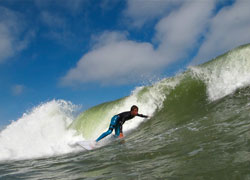With our ocean resembling a lake for the first week of school, the predicted swell for this past week had MU’s surfers frothing. High winds, a ripping current and massive Monday and Tuesday waves saddened surfers across the board.
Wednesday morning, as I found my way to an 8:30 am class, the sun was shining and the wind was nothing more than a soft reminder of the previous days. I smiled to myself as my professor let us out ten minutes early and immediately notified others who like to surf of the day’s conditions.
Wednesday ended up delivering chest high barrels to local surf spots. Surfers beamed as they walked down to the beach, nothing but board shorts and a surfboard under their arm. A warm September sun shone in their eyes as surfer by surfer paddled out to the lineup. All day, surfer’s schedules consisted of surfing, eating and more surfing. On Thursday morning, the waves lasted for only a short period but surfers on dawn patrol rejoiced to find clean, sizeable waves during that time. Conclusively from Wednesday morning to Thursday morning, there were waist to chest high waves at most spots around our area.
One spot in particular has been very quiet this year after it was recently dredged. Before it was dredged, the Pit, was a go-to spot for many surfers last year.
“Dredging is the process of removing bottom sediment in the ocean for several different purposes. navigable waterways must constantly be maintained at a certain depth to allow for passage and must be dredged to do so,” senior marine and environmental biology and policy major Amanda Billotti said. “In addition dredged material is used to replenish beaches that are eroded. The problem with dredging is it disturbs the benthic ecosystem and the sediment may contain toxic chemicals and metals that have previously settled.”
At the Pit, MU surfers were sure to find a familiar face and a solid wave. Late last spring, the town began to dredge the beach, and buried the rock jetties with sand to extend the beach. The jetties that once made the waves break were turned into a nonfactor and in the end ruined the once prosperous surf spot.
For example, the jetties made the beach a point break; this means that swell would break off of the rocks, allowing waves to form. This is not the first time that something like this has happened nor will it be the last. All across the state’s beaches, the surrounding towns take sand from the ocean floor and add it to the beach in order to lengthen them. This could be helpful to towns in our area to protect against the rising waters of any possible hurricane.
Many places also dredge in order to commercialize their beaches. By making their beaches longer the town of Long Branch can advertise their beaches that can now fit almost double the amount of people that it once did. Beach dredging demolishes the work that Mother Nature has done to give surfers a surfing beach.
Around the University, not many people are happy about the new look at the Pit. “I’m not a big fan that they dredged the Pit. Without the jetties in place we don’t really have that point break anymore. I miss the smaller more secluded beaches; they’re too big now,” said Tyler Sankey after seeing the Pit for the first time since last semester.
Not only do surfers feel animosity toward the dredging but also so do the spongers. To clarify, sponging is the same thing as boogie boarding, but basically more ‘rad’ than the average six-year-old playing in the shore break on a broken piece of foam. Either way, spongers love to get pitted just as much as any surfer does.
Connor Perzely, a student sponger said, “Definitely a bummer how they dredged the place. The jetty is gone and the break is crumbly. The beach is massive now and there’s a lot more people around. [It is] definitely a different scene.”
For a surfer, sponger or anywhere in between, it is obvious that the dredging can have an affect on anyone who loves to visit the local beaches. Moving past that, while one cherished surf location has been destroyed, there are still waves to be had. This coming week, a hurricane named Eduard is moving up the Atlantic coast. Currently, Eduard is stationed in the middle of the Atlantic and is not planning on making any appearances on our shores.
Instead, Eduard will run along parallel to the coast, close enough to deliver us with swell and far enough to have little to no impact on our weather. Eduard is presently a category one hurricane but could possibly strengthen to a category three by mid-week.
Consequently, Wednesday and Thursday this week are looking like the best days to be a surfer. Eduard should give NJ clean, chest high waves from Wednesday afternoon to Thursday afternoon. Having said that, don’t get too down about the Pit; find a new spot, get stoked, and get out there.
PHOTO COURTESY of Chris Norcross


